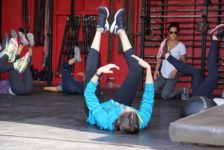
The following is a guest entry from B!RTHF!T Senior Leadership Team member, founder of Coulee Health in La Crosse, Wisconsin, and Dynamic Neuromuscular (DNS) Level-D Certified practitioners from the Prague School of Rehabilitation and Manual Medicine, Dr. Erica Boland DC.
Last week, DEUCE Gym upped the core ante in the blog post Intra-Abdominal Pressure and Back Health. Maybe you haven’t thought of movements like the squat, bench press, or pull-ups as core strengthening up until this point. But now you are in on the secret, every day is core day. Because every movement comes through the core.
While “functional movement” is #trending, much of the fitness industry touts building concentric strength and under-appreciates the necessity of eccentric stability.
Intra-abdominal pressure (IAP) is created through an eccentric contraction of the core. Cue bracing as if someone were going to punch you in the stomach. This eccentric contraction is what provides the most stability. More stability opens more access to gains in both strength AND endurance.
Think of the core as a pressurized canister with the following key players: diaphragm, pelvic floor, obliques (internal and external), rectus, transversus, and all lumbar erectors. Diaphragm and pelvic floor are the top and bottom of the canister, the other key players the cylinder.
The MVP here is the diaphragm. For IAP to occur the diaphragm must first eccentrically contract or move down, it is then counteracted by the pelvic floor, and the rest of the key players can follow suit.1,2 Nothing but a situation of right player, right time.
To recruit the diaphragm to work for you, you must train it in both it’s breath and stability (IAP) roles. Like any other muscle, if you don’t use it you lose it. Ideal diaphragmatic breath sends your breath down into your core and all 360 degrees around the waistband of your favorite sweats. This is the mobility work for your diaphragm. In addition to greater oxygen access, it allows the diaphragm to reach full ROM for stability (IAP). Then, do both at once: stabilize and breathe. You see why she’s the real MVP.
Once you have breath and IAP established, these concepts can be applied to every single movement.
No one knows movement better than Dynamic Neuromuscular Stabilization. Based in the Czech Republic, they use the way we were born to move to assess and treat athletes around the globe.
Those movements you are starting to see more often around DEUCE, the functional progressions, dead bugs, bracing drills, are all based on DNS principles and developmental positions.
“Essentially, “every developmental position is an exercise position”3 however, each exercise must follow some basic principles: 1. Restore proper respiratory pattern and IAP regulation; 2. Establish a good quality of support for any dynamic movement of the extremities; and 3. Ensure that all joints are well centered throughout the movement. Resistance or load should be matched to the athlete’s ability to maintain proper form during the exercise or drills.”4
It is as simple as returning to these fundamentals daily. When these principles are respected, the sky’s the limit.
Erica Boland, DC
@birthfitwisconsin
@couleehealth
- Kolar P, Neuwirth J, Sanda J, Suchanek V, Svata Z, Pivec M. Analysis of diaphragm movement during tidal breathing and during its activation while breath holding using MRI synchronized with spirometry. Physiol Res 58:383-392, 2009
- Kolar P, Sulc J, Kyncl M, Sanda J, Neuwirth J, Bokarius AV, Kriz J, Kobesova A. Stabilizing function of the diaphragm: dynamic MRI and synchronized spirometric assessment. J Applied Physiol Aug 2010
- Kolar P: Facilitation of Agonist-Antagonist Co-activation by Reflex Stimulation Methods In: Craig Liebenson: Rehabilitation of the Spine – A Practitioner’s Manual. Lippincott Williams & Wilkins; 2nd edition 2006531–565
4. Frank C, Kobesova A, Kolar P. DYNAMIC NEUROMUSCULAR STABILIZATION & SPORTS REHABILITATION. International Journal of Sports Physical Therapy. 2013;8(1):62-73.
11/6/17 WOD
Build to Heavy Strict Press…
Then, EMOM 15
Minute 1: 7 Thrusters (95/65)
Minute 2: 7 Burpees
Minute 3: 7 Pull Ups
